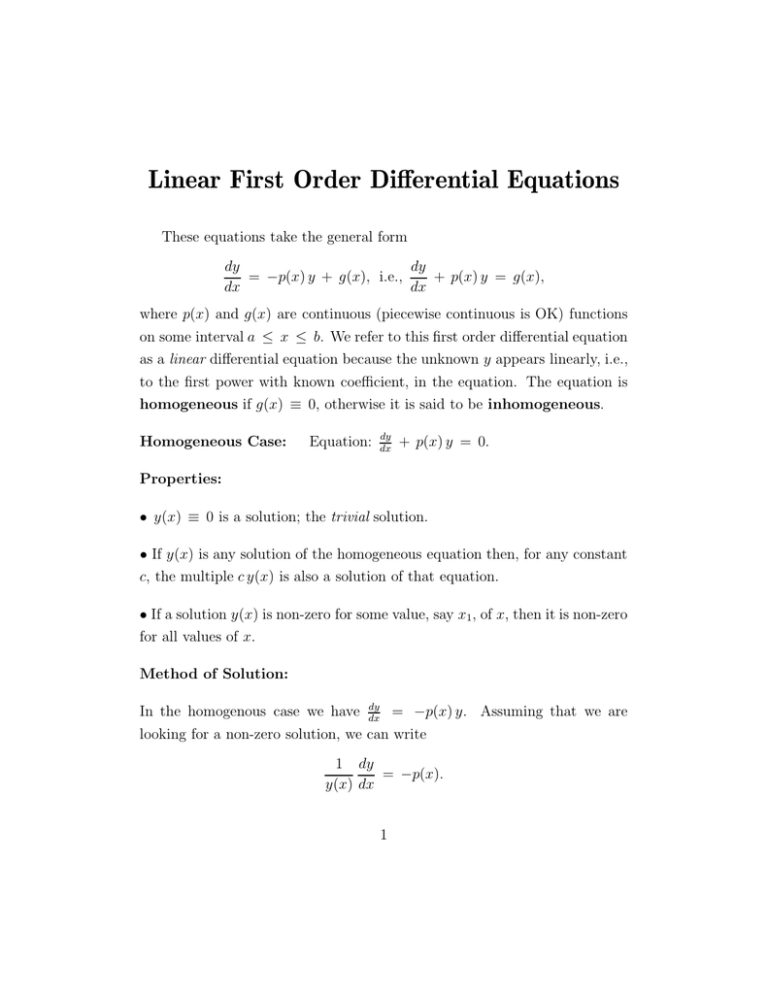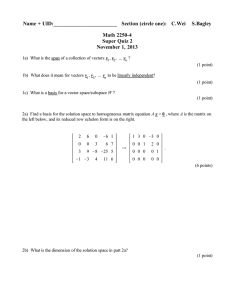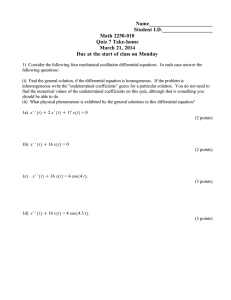Linear First Order Differential Equations
advertisement

Linear First Order Differential Equations
These equations take the general form
dy
dy
= −p(x) y + g(x), i.e.,
+ p(x) y = g(x),
dx
dx
where p(x) and g(x) are continuous (piecewise continuous is OK) functions
on some interval a ≤ x ≤ b. We refer to this first order differential equation
as a linear differential equation because the unknown y appears linearly, i.e.,
to the first power with known coefficient, in the equation. The equation is
homogeneous if g(x) ≡ 0, otherwise it is said to be inhomogeneous.
Homogeneous Case:
Equation:
dy
dx
+ p(x) y = 0.
Properties:
• y(x) ≡ 0 is a solution; the trivial solution.
• If y(x) is any solution of the homogeneous equation then, for any constant
c, the multiple c y(x) is also a solution of that equation.
• If a solution y(x) is non-zero for some value, say x1, of x, then it is non-zero
for all values of x.
Method of Solution:
In the homogenous case we have
dy
dx
= −p(x) y. Assuming that we are
looking for a non-zero solution, we can write
1 dy
= −p(x).
y(x) dx
1
Integrating both sides with respect to x, we have (natural logarithm)
log |y(x)| = −
Z
x
p(s) ds + ĉ ≡ −P (x) + ĉ,
where ĉ is an arbitrary constant. Taking the exponential of both sides we
have the general solution
y(x, c) = eĉ exp{−
Z
x
p(s) ds} = c e−P (x) ,
where P (x) is, as already indicated, an antiderivative of p(x).
Example 1
Consider the differential equation x dy
+ y = 0; in the standx
dard form this is
dy
1
+ y = 0,
dx
x
1
corresponding to p(x) = x ; an antiderivative is P (x) = log |x|. We therefore
obtain solutions
c
c
y(x, c) = c e− log x = log x = .
e
x
For y(x, c) thus specified we have
dy
dx
= − xc2 and we verify immediately
that this is, indeed, a solution for every value of c. If we impose an initial
condition, e.g., y(2) = 1, we require 2c = 1 which fixes the value of c at 2.
We can give a general formula for the solution of an initial value problem y(x0) = y 0 . Since the general solution is c e−P (x) , satisfaction of this
condition requires
c e−P (x0 ) = y 0 ⇒ c = eP (x0 ) y 0.
With this value of c the solution becomes
y(x) = e
P (x0 )
y0 e
−P (x)
= e
−(P (x)−P (x0 ))
2
y 0 = exp −
Z
x
x0
p(s) ds y 0 .
Thus if we want the solution of the above differential equation with y(2) = 3
that solution is
y(x) = exp −
Z
ds
s
x
2
!
3 exp log
3 = 3 exp (log(2) − log(x)) =
2
x
= 3
2
6
= .
x
x
Consider the equation
The Inhomogeneous Case:
dy
dx
+ p(x) y = g(x)
with g(x) not identically 0. First, some
Properties:
• If y(x) is any solution of
dy
dx
dz
dx
+ p(x) y = g(x) and z(x) is any solution of
the homogeneous equation
+ p(x) z = 0, then w(x) = y(x) + z(x) is a
solution of dw
+ p(x) w = g(x).
dx
• The general solution of
dy
dx
+ p(x) y = g(x) has the form y(x, c) + y1 (x),
where y(x, c) is the general solution of the homogenous equation and y1(x)
is any (particular) solution of the inhomogenous equation. Thus the general
solution of the inhomogenous equation takes the form
y(x) = c e−P (x) + y1(x).
Verification of the first property follows, with w(x) = y(x) + z(x), from
0 =
dy
+ p(x) y − g(x)
dx
!
+
dz
+ p(x) z
dx
!
=
dw
+ p(x) y − g(x).
dx
The second follows from the equivalence of the equations
y (x 0 , c) + y 1 (x 0) = y 0 and y (x 0, c) = ŷ 0 ≡ − y 1 (x 0) + y 0.
3
Example 2
dy
+ y = 0 we have seen
For the differential equation x dx
that the general solution takes the form y(x, c) =
c
.
x
If we now consider a
corresponding inhomogeneous equation
x
dy
+ y = x3 ,
dx
we can verify that one solution, i.e., a particular solution, is y1 (x) =
1 3
x .
4
It
follows that the general solution takes the form
y(x) =
c
1
+ x3 .
x
4
The initial value problem y(2) = 1 now requires
c = 2 − 2×
y(x) =
−2
x
8
4
c
2
+
1
4
× 23 = 1, i.e.,
= −2. So the solution of the initial value problem is
+ 14 x3.
General Method of Solution: Variation of Parameters Formula
We now try to find a general method for solving the inhomogeneous equation
dy
+ p(x) y = g(x).
dx
The general solution of the homogeneous equation takes the form y(x) =
c e−P (x) , where P (x) is an antiderivative of p(x) and c is an arbitrary constant,
or parameter. Various considerations lead us to try for a solution of the
inhomogeneous equation in which this parameter is replaced by a variable
quantity:
y1(x) = c (x) e−P (x) .
Hence the name “method of variation of parameters”. Substituting this
assumed form of the solution into
dy
+ p(x) y = g(x)
dx
4
gives
dc −P (x)
e
− c(x) e−P (x) p(x) + p(x) c(x) e−P (x) = g(x)
dx
so that
dc
= eP (x)g(x).
dx
We may then write
c(x) =
and y1(x) assumes the form
Z
x
y1(x) = e−P (x)
eP (s) g(s) ds
Z
x
eP (s) g(s) ds.
Since the general solution has the form y(x, c) = c e−P (x) + y1(x), we have
for the inhomogeneous equation the general solution
Z
y(x, c) = c e−P (x) + e−P (x)
x
eP (s) g(s) ds.
A specific solution is obtained by fixing c and the lower bound for the integral,
which have equivalent roles. If we want y (x 0) = y 0 it is often convenient to
take the lower limit as x 0 so that
Z
y(x, c) = c e−P (x) + e−P (x)
x
eP (s) g(s) ds.
x0
When x = x 0 the integral vanishes and
y0 = ce
−P (x 0 )
⇒ y(x) = e
−(P (x)−P (x 0 ))
y0 + e
−P (x)
Z
x
x0
eP (s) g(s) ds.
However, it is not generally essential to take the lower limit of the integral
to be the initial value x 0, as we see from
Let us consider the differential equation
Example 3
x
dy
+ y = x sin x
dx
or
5
dy
1
+ y = sin x.
dx
x
Here p(x) =
1
x
with antiderivative P (x) = log x. Then e−P (x) =
1
,
x
eP (x) = x; we can take
c
1
y(x, c) =
+
x
x
Z
0
x
s sin s ds.
Computing the integral, we have
y(x, c) =
c
1
c
sin x
+
sin x − x cos x =
+
− cos x.
x
x
x
x
Solutions satisfying particular initial conditions can now be obtained via
appropriate choice of the parameter c. Thus if we want y(π/2) = 0 we need
2
2c
+
− 0 = 0 −→ c = −1
π
π
and the desired solution is
y(x) = −
Remark
sin x
1
+
− cos x.
x
x
Despite the singularity of p(x) =
1
x
at x = 0 there is, in this
case, a solution corresponding to the initial condition y(0) = 0. Since
lim
x↓0
sin x
= 1 = cos 0
x
we obtain such a solution with the choice c = 0, i.e.,
y(x) =
sin x
− cos x.
x
It should be noted, however, that we cannot give a general initial condition at
x = 0; for example, if we wanted y(0) = 1 we would arrive at the equation
c
0
= 1, which makes no sense.
6




